nando
Been here a while!  The Frying Dutchman
Always look on the bright side of life
The Frying Dutchman
Always look on the bright side of life
Posts: 393 
|
Post by nando on Jun 24, 2017 20:38:18 GMT
[Edit] Things I want to do with the Nu-Vista: Utimate goal: -Get better 3d soundstage and nicer, more natural sound overall -Make the amp last for decades to come -Get the more out of this amp. Actions: 1 Replace all capacitors with better sounding, more durable ones and add more capacity at the same time. 2 Replace cinch sockets with newer ones and maybe ones with a screwmount (?). 3 Repair the tuner input (doesn't work anymore). Firstly resolder 4 Repair volume crackle. Firstly resolder 5 Replace the few black diodes. 6 Place some cooling fins on some transistors which are running hot. 7 Replace Nu-vistor (6CW4) tubes. 8 Clean the pcb. 9 Maybe replace op-amp with a better one. 10 Maybe replace the 2 rectifiers with faster ones [original first post of this topic] At last I opened up my Nu-Vista pre amp. A little gear p*rn below. This amp is a few years old (1998?) and I can't find any photo's of the inside of this amp. So here is maybe a world première. I hope you like it and I can learn something new. There are a few problems with the amp. The tuner input stopped working a few years back and the input selector knob crackles a little when changing the input. I opened both the amp and the power supply. I wasn't all too pleased with what I found. As far as I know there are a lot of cheap components inside but this can be changed. On the large board there are a lot of these brown staines while other components are completely clean. These staines were mostly at the solderings of the transistors, selector-knob and the tubes. There was also a stain at one of the soldering of the power cables. My guess is that the board gets hot and the soldering is suffering. So is there a problem to be solved here? Here are the photo's. 1. The Nu Vista is as cramped as other MF cans. 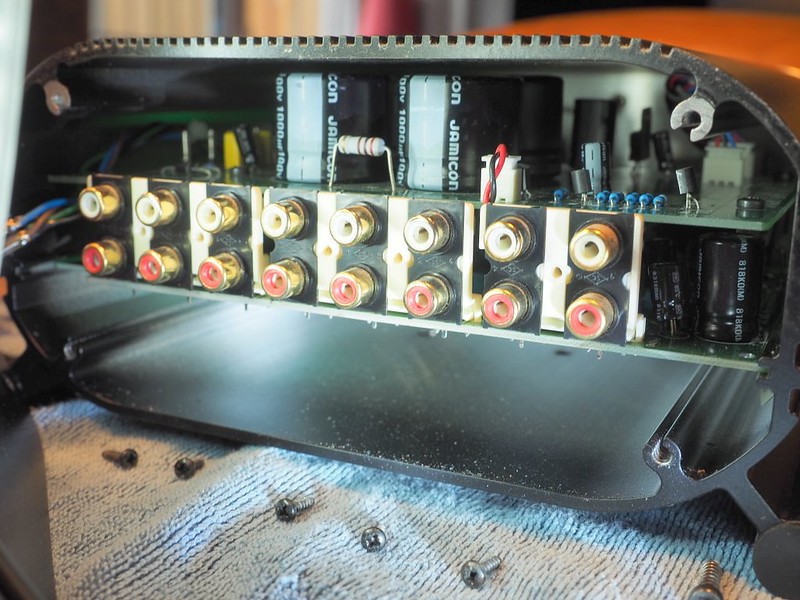 2. This is the top view. No mods were made (yet). 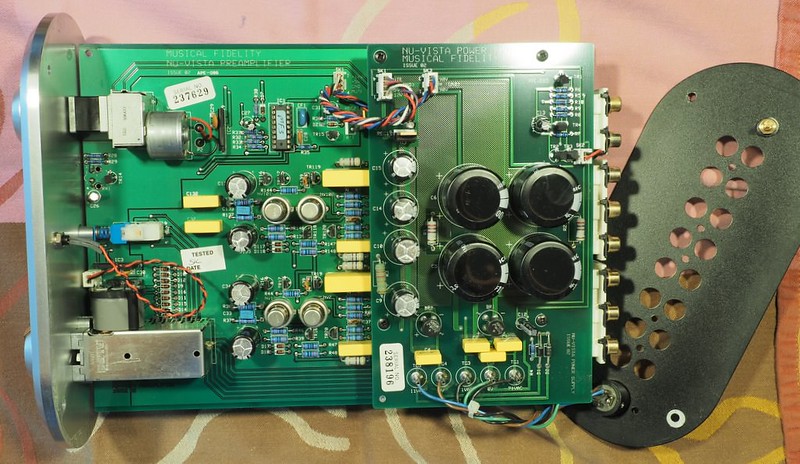 3. This is why the amp is called Nu-Vista. These are the metal case tubes. 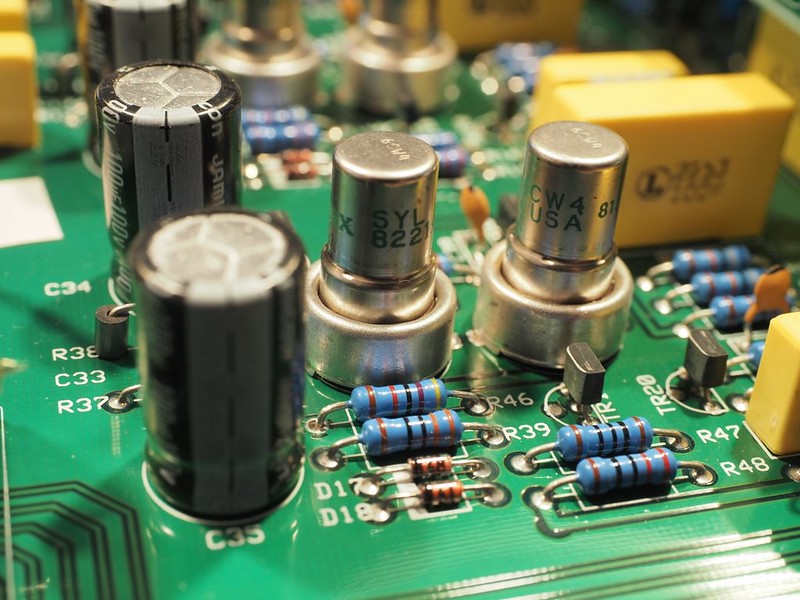 4. 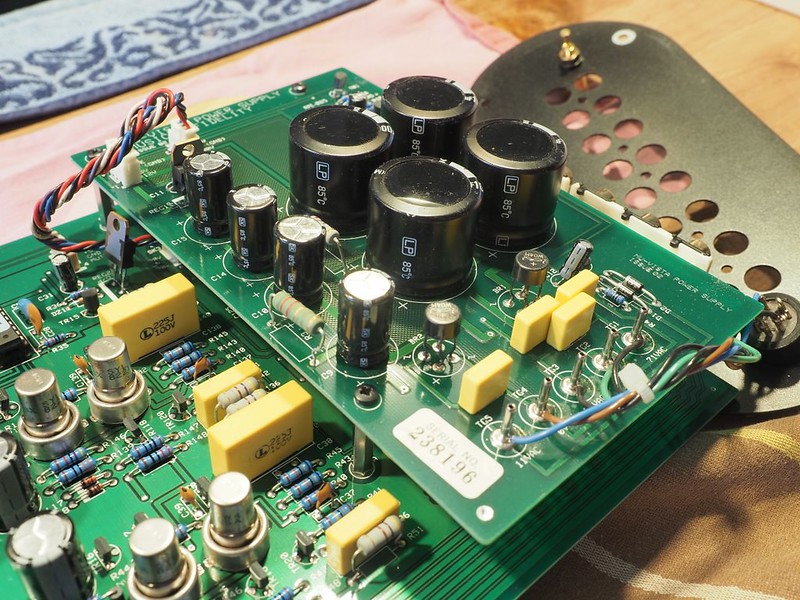 5. View from the other side. 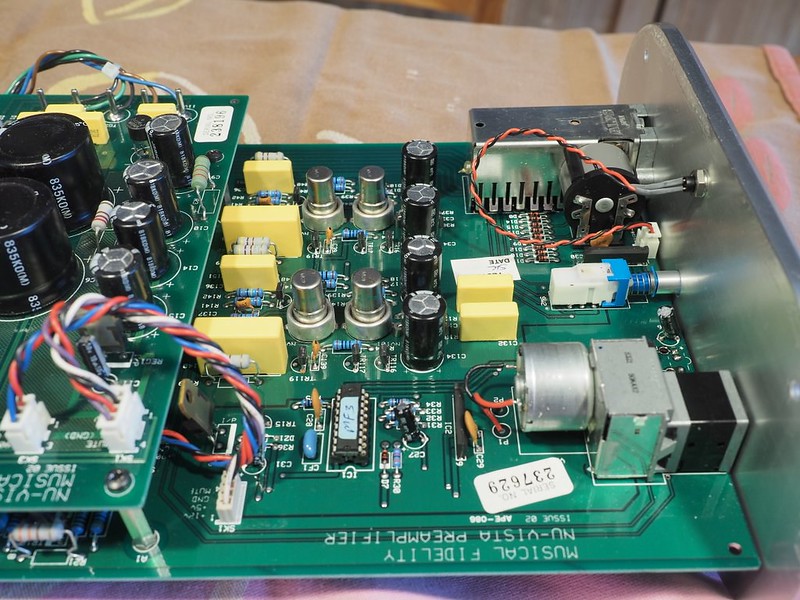 6. I carefully pulled out one of the tubes. These are as large as the top digit of my little finger. 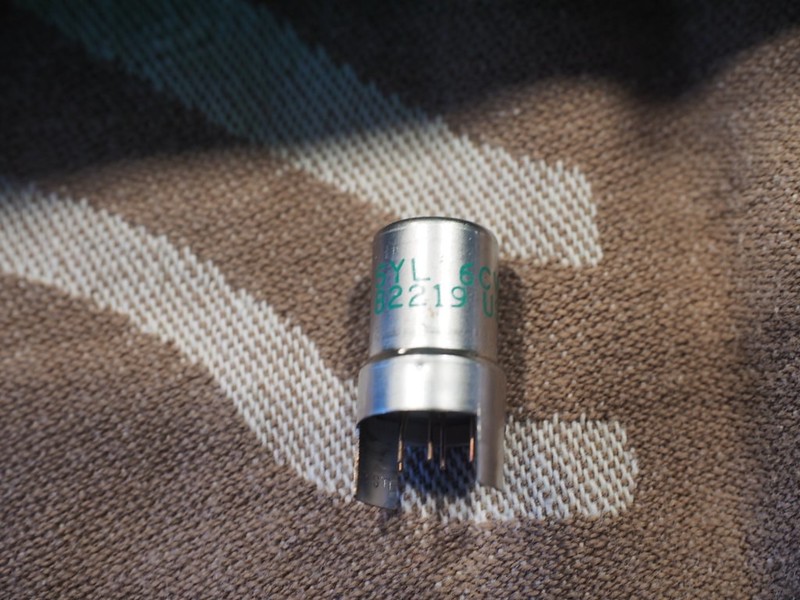 7. Are there better ones for these? 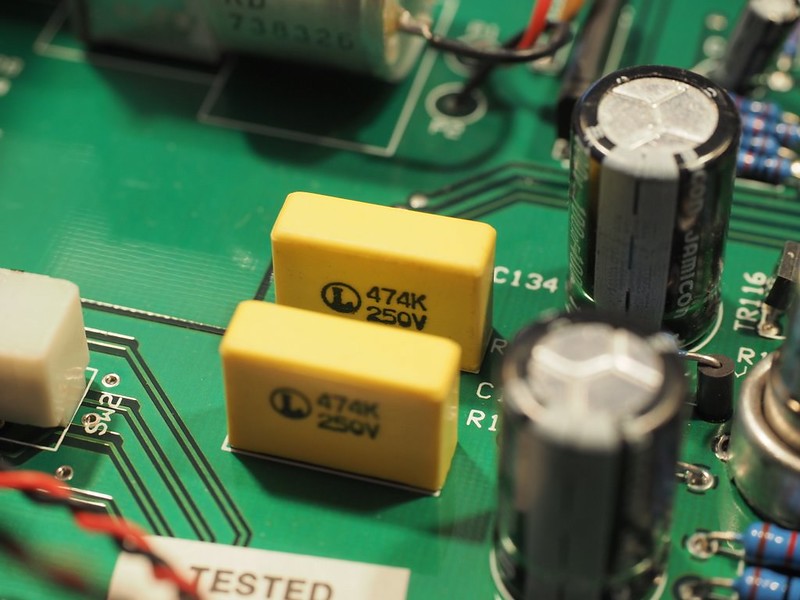 8. I wonder what the thing on four legs is (no not a spider without for of it's legs). 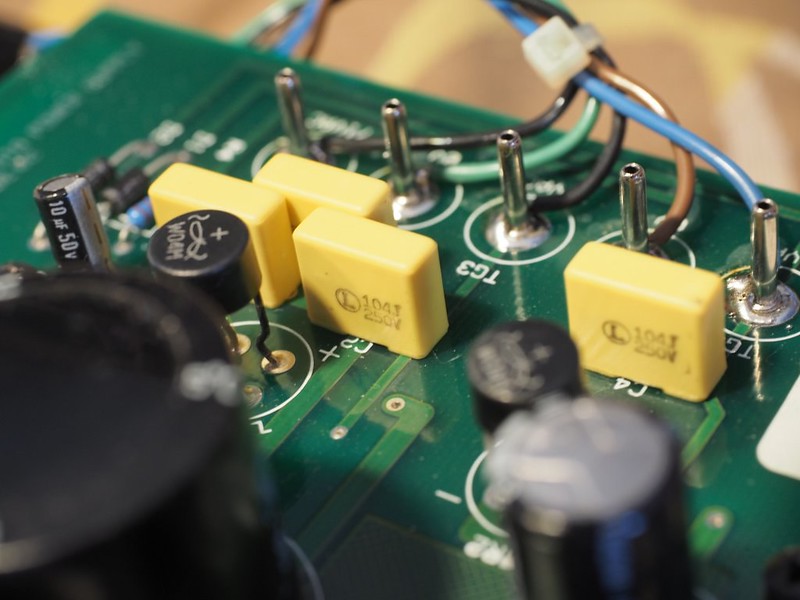 9. Wonder what the thing on four legs is. 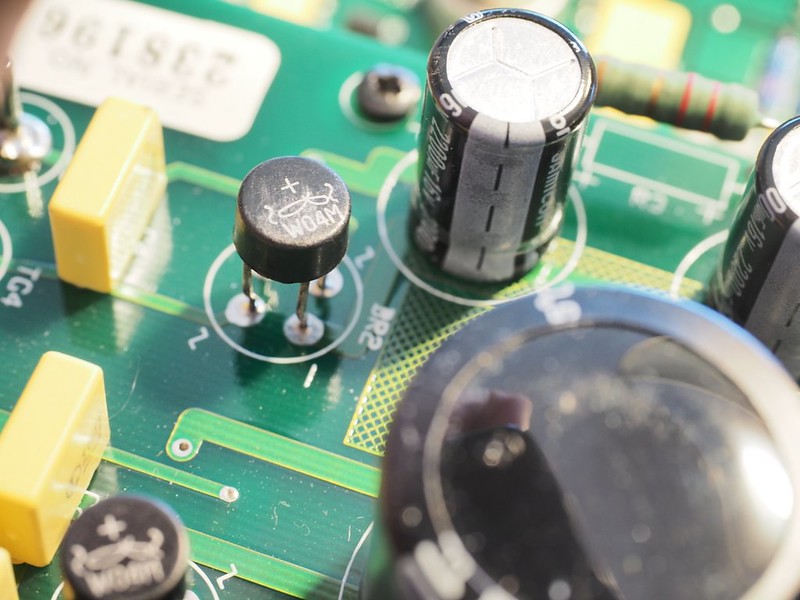 10. Soldering of the selectorknob. 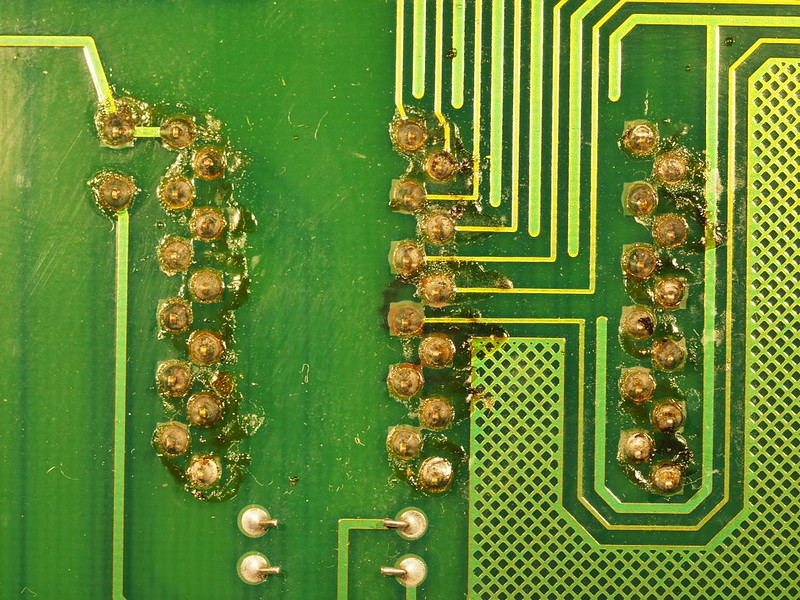 11. Brown staines at the soldering of transistors. The solderings of the resistors and elco's were clean. 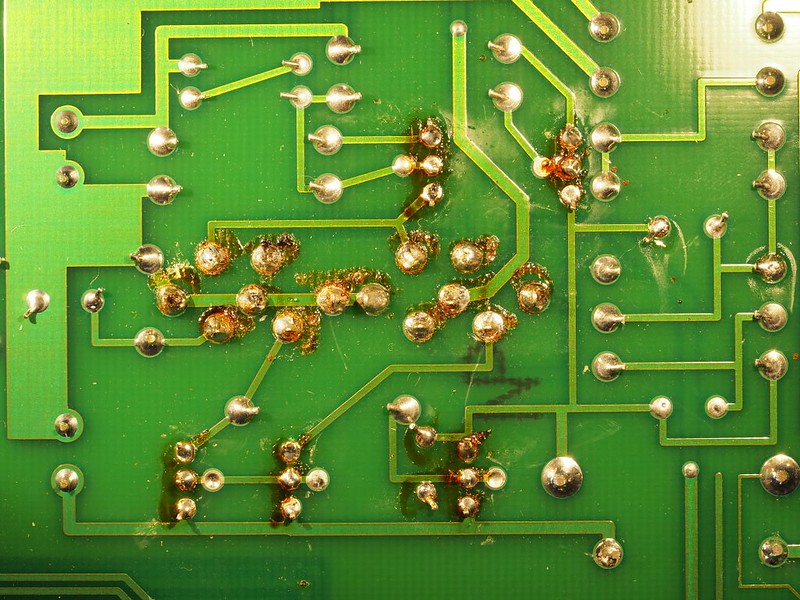 12. Again solderings of transistors.  13. Again... transistors. 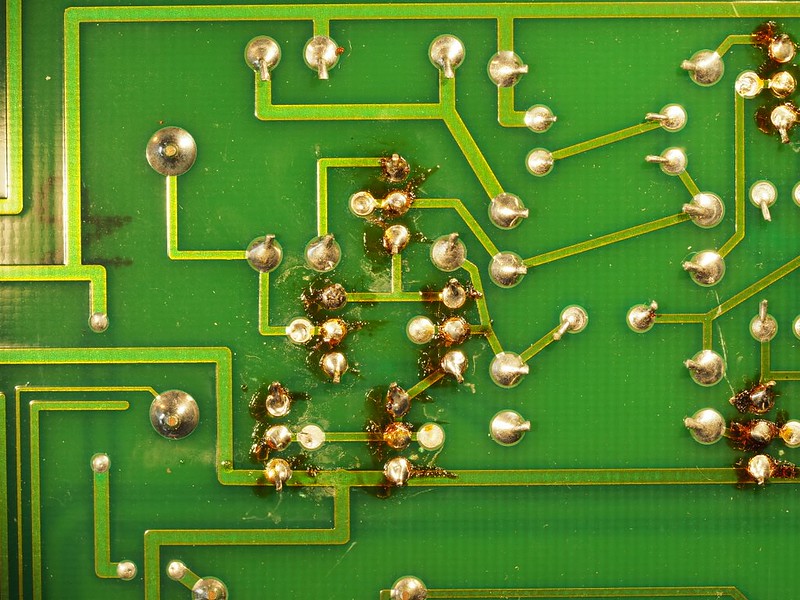 14. You get the idea by now... 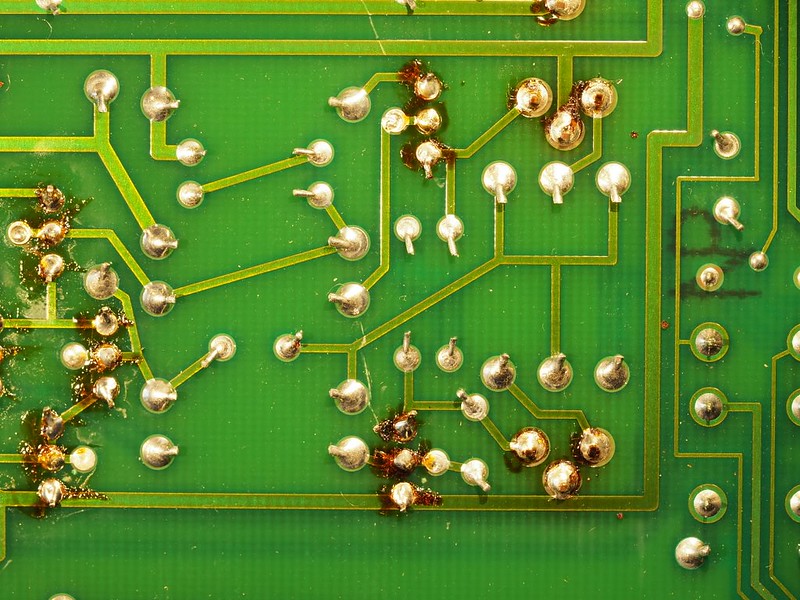 15. Volume knob  16. One of the cables from the power supply. 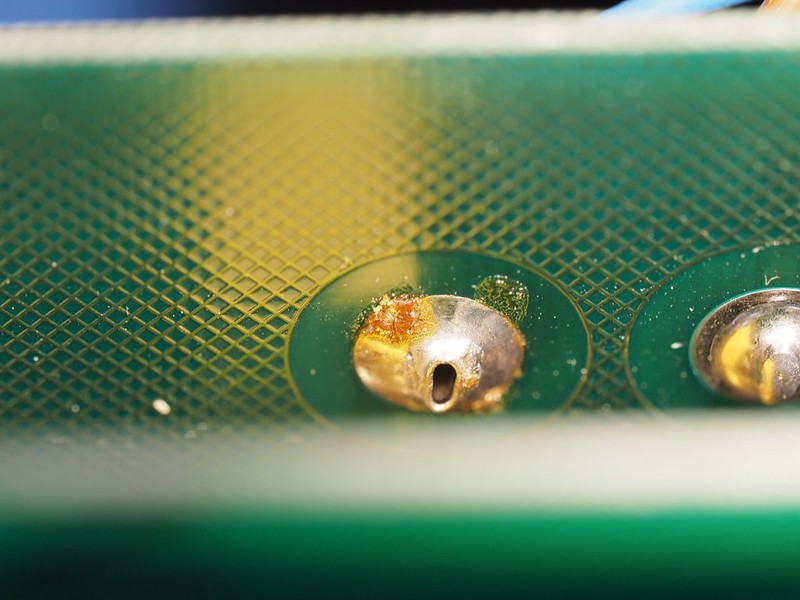 17. The large elco's only just fit inside the casing.  18. The power supply is a lot like the x-psu. I only containes a toroid transformer, a metal plate (which the x-psu doesn't have) and some cables. 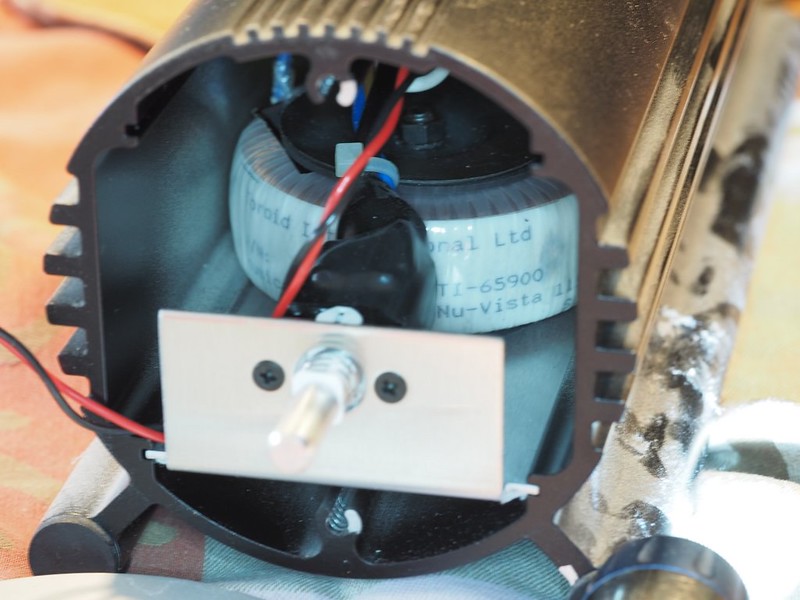 19. 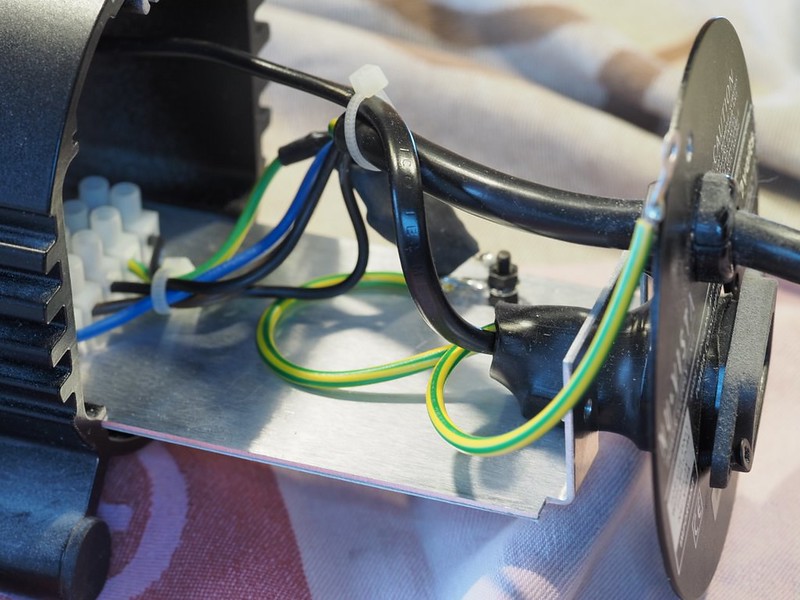 20. Inside of the power supply from behind. 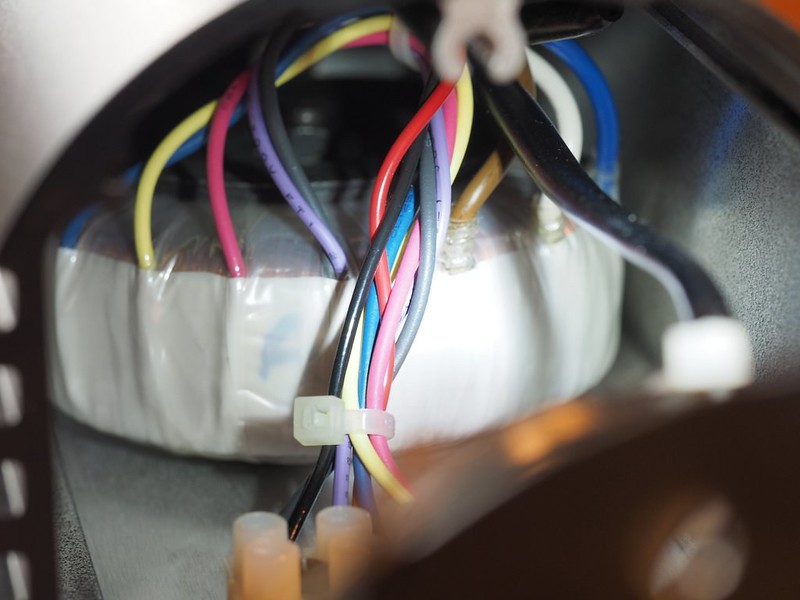 |
|
|
|
Post by freddypipsqueek on Jun 25, 2017 10:13:56 GMT
The 4 legged thing is a voltage (bridge) rectifier for the AC to DC. Modern fast recovery diodes may be better but I'm not sure the right replacements.
I think the brown stuff is the flux from the solder coming out because of the heat/voltage - nothing to worry about. It should scrape off with care and a sharp blade.
A dry joint on the tuner input is likely so reheat the solder on all of the inputs and add if need be - you could remove the original with a sucker and replace but reheating should be good enought to get that inpout working.
The yellow things are capcitors and could be replaced but you need a plan at that point and I would be tempted to replace the tubes before anything as they probably need it.
A.
|
|
nando
Been here a while!  The Frying Dutchman
Always look on the bright side of life
The Frying Dutchman
Always look on the bright side of life
Posts: 393 
|
Post by nando on Jun 25, 2017 10:42:20 GMT
The 4 legged thing is a voltage (bridge) rectifier for the AC to DC. Modern fast recovery diodes may be better but I'm not sure the right replacements. I think the brown stuff is the flux from the solder coming out because of the heat/voltage - nothing to worry about. It should scrape off with care and a sharp blade. A dry joint on the tuner input is likely so reheat the solder on all of the inputs and add if need be - you could remove the original with a sucker and replace but reheating should be good enought to get that inpout working. The yellow things are capcitors and could be replaced but you need a plan at that point and I would be tempted to replace the tubes before anything as they probably need it. A. Thanks! A rectifier. But do you reckon it's to hot inside the Nu-Vista? Replace the tubes? These are 6cw4 tubes and should be good for a 100.000 h, that's 11 years. |
|
|
|
Post by freddypipsqueek on Jun 25, 2017 12:26:28 GMT
Hot - no - If its working ok I doubt it's too hot. MF will have got the heat thing right. There are bits though, such as the transisters, that get hot locally. It just happens. I wouldn't worry about the solder.
Mike may be able to comment on the tubes - My amp is on all the time (which would cover the 11 years) buts its solid state.
The input switch is likely ot be dirty - a bit of Servisol may help clean it but I would be worried about the motor for the remote so it maybe better to see if it can be unsoldered & removed before cleaning albeit that look like a job and a half as the solder will need to be wicked throught to the track if its at the top and you are soldering the bottom.
A.
|
|
nando
Been here a while!  The Frying Dutchman
Always look on the bright side of life
The Frying Dutchman
Always look on the bright side of life
Posts: 393 
|
Post by nando on Jun 28, 2017 9:55:24 GMT
You are probably right about cleaning and desoldering the input switch. That thing has a lot of solderpoints.
I haven't run the amp 24/7 but at least several hours a day, every day.
|
|
nando
Been here a while!  The Frying Dutchman
Always look on the bright side of life
The Frying Dutchman
Always look on the bright side of life
Posts: 393 
|
Post by nando on Jul 30, 2017 20:30:37 GMT
For planed changes see first post. This will be updated.
|
|
nando
Been here a while!  The Frying Dutchman
Always look on the bright side of life
The Frying Dutchman
Always look on the bright side of life
Posts: 393 
|
Post by nando on Jul 30, 2017 21:19:09 GMT
|
|
|
|
Post by PinkFloyd on Jul 31, 2017 8:38:57 GMT
|
|
|
|
Post by PinkFloyd on Jul 31, 2017 8:39:47 GMT
What values are the Yellow film caps?
|
|
nando
Been here a while!  The Frying Dutchman
Always look on the bright side of life
The Frying Dutchman
Always look on the bright side of life
Posts: 393 
|
Post by nando on Jul 31, 2017 10:27:57 GMT
What values are the Yellow film caps? There are two different yellow condensers. Big ones: 225J 100V Small ones: 474J 250V  Another image of the smalleer yellow ones of the last photo. It says 474K 250V 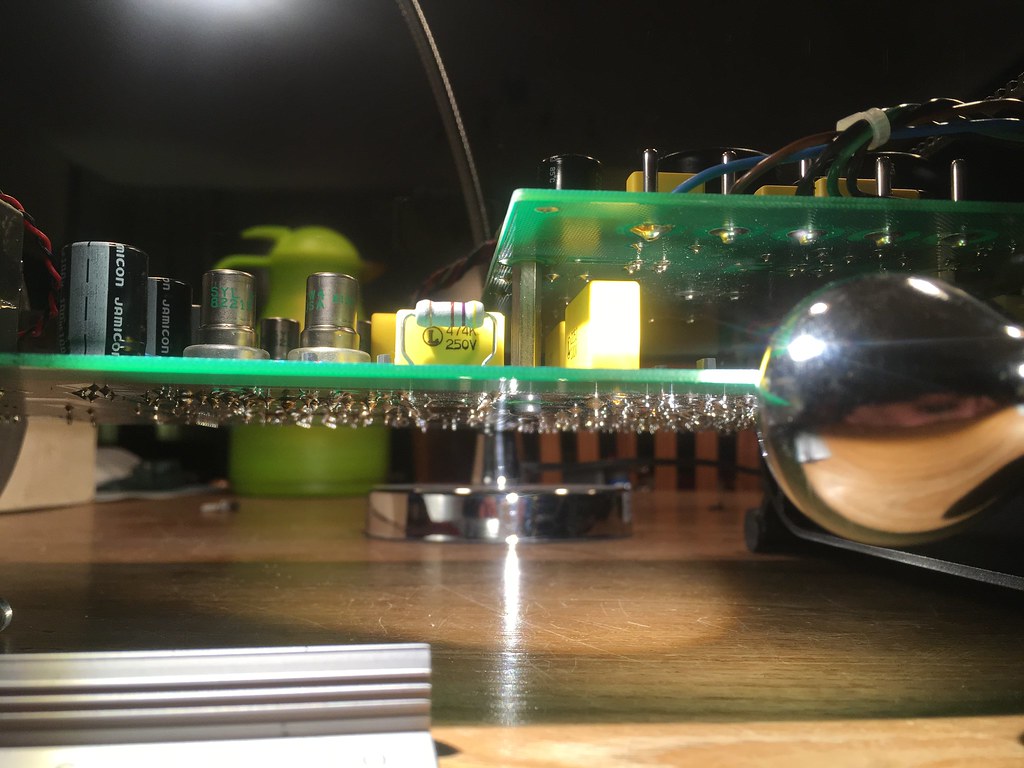 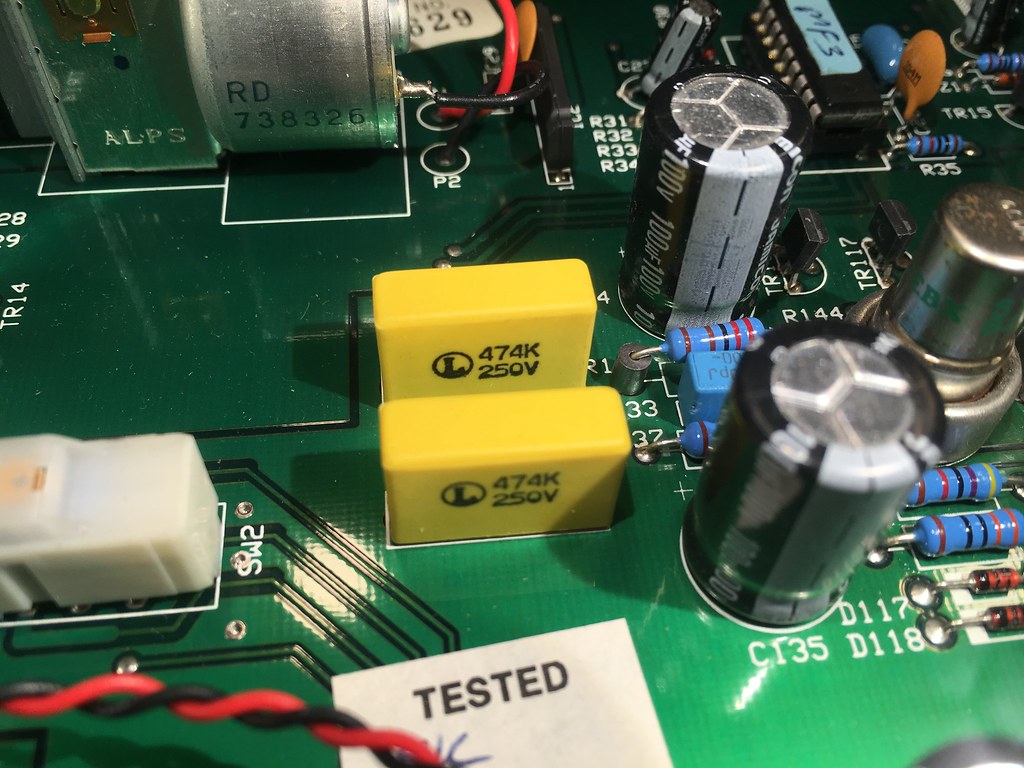 Some little ones cramed together. 1N2J and 8N2J 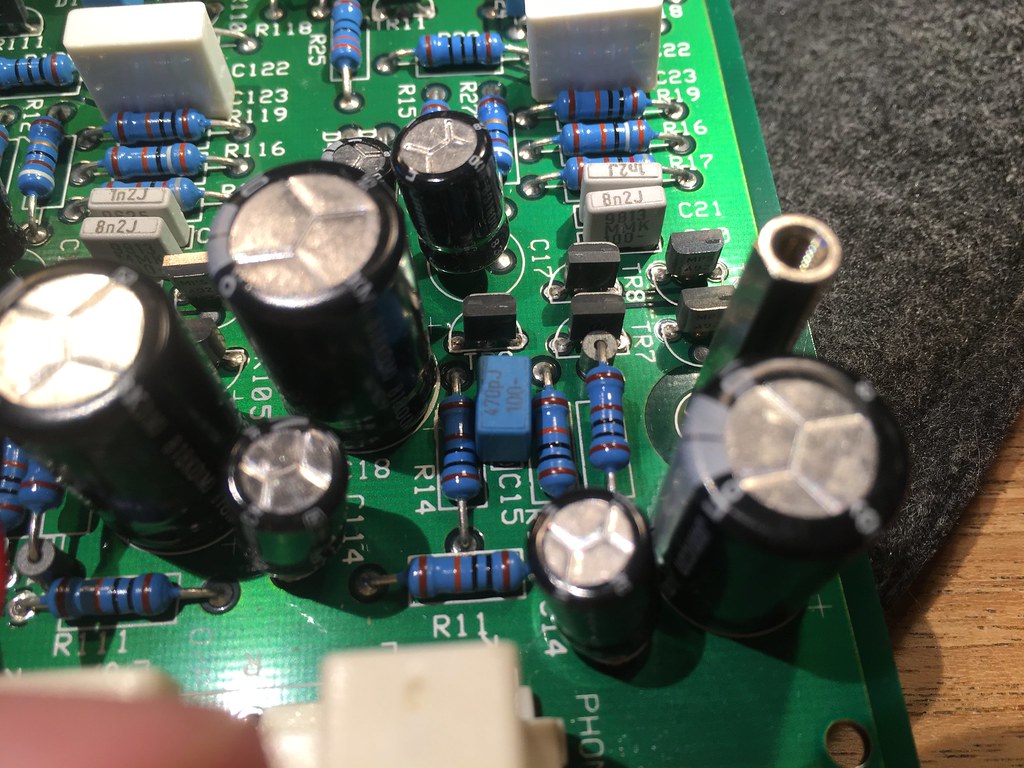 These bigger white ones: 333J 250V. The little blue ones (Evox): 470pJ 100- Other blue (Evox): 330pJ 100-  Is it worth changing these tantalum condensers? Sound and/or durability wise? |
|
|
|
Post by PinkFloyd on Jul 31, 2017 10:53:11 GMT
What size are the 225J yellow caps? H x W x D mm
|
|
|
|
Post by PinkFloyd on Jul 31, 2017 11:07:37 GMT
The reason I ask is I have a box of NOS EVOX PMR polypropylene 2.2uF / 160V that may be excellent candidates to replace the yellow metallized film caps with but the PMR caps may be a bit bigger: 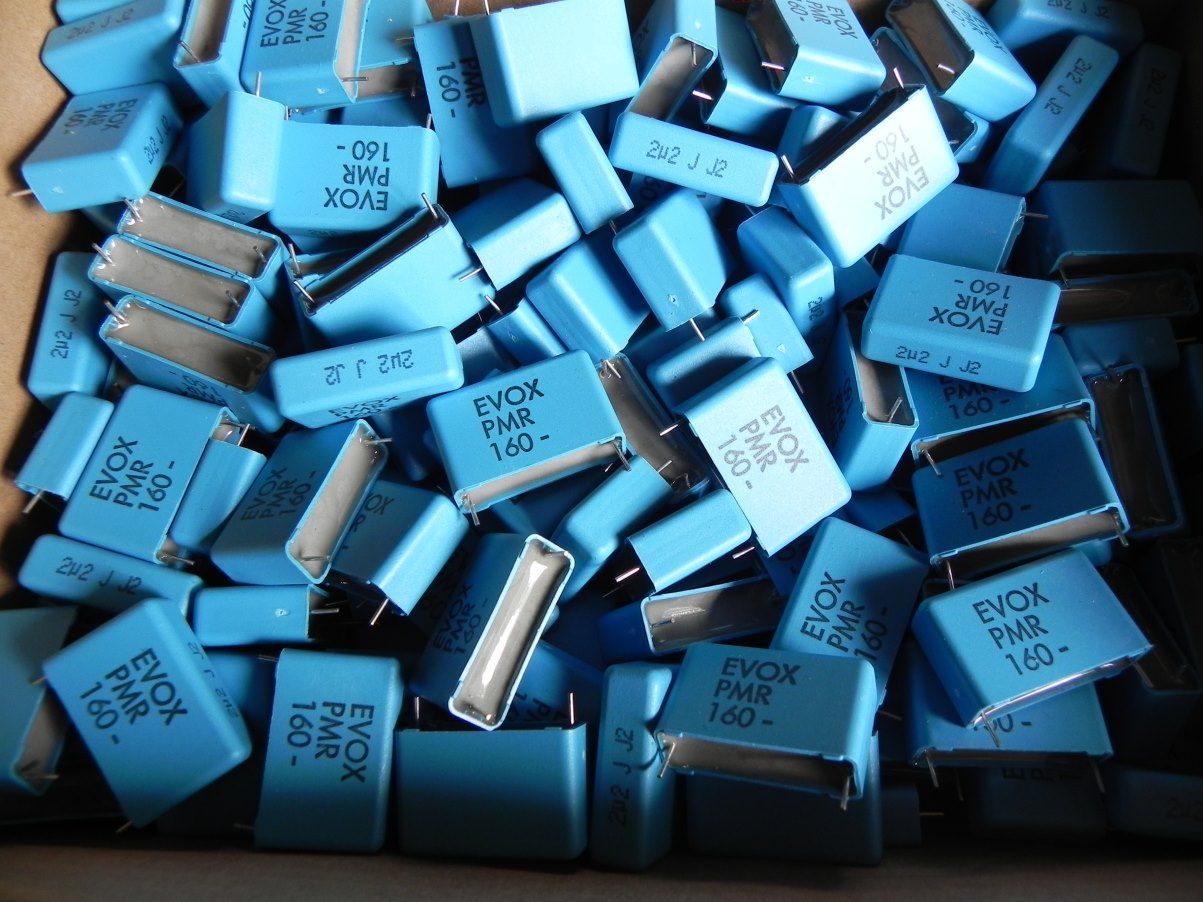 |
|
nando
Been here a while!  The Frying Dutchman
Always look on the bright side of life
The Frying Dutchman
Always look on the bright side of life
Posts: 393 
|
Post by nando on Jul 31, 2017 19:21:37 GMT
I measured most of the bigger condensers and how much room they have to spare above them in the casing or under the next pcb and put it in a excelsheet (so I don't have to open the thing every time I want to know something). I will send you the excelsheet via mail.
But about the evox pmr's... The (in Dutch) raster (space between pins) of the 225J's is 2,1 cm. Max height of some is 5,4 cm but the ones under the power pupply pcb only have 2,4 cm from pcb to pcb.
What does the "225J" and "2u2 2J" mean? J for Joule?
|
|
|
|
Post by PinkFloyd on Jul 31, 2017 20:24:09 GMT
I measured most of the bigger condensers and how much room they have to spare above them in the casing or under the next pcb and put it in a excelsheet (so I don't have to open the thing every time I want to know something). I will send you the excelsheet via mail. But about the evox pmr's... The (in Dutch) raster (space between pins) of the 225J's is 2,1 cm. Max height of some is 5,4 cm but the ones under the power pupply pcb only have 2,4 cm from pcb to pcb. What does the "225J" and "2u2 2J" mean? J for Joule? Oh...... the PMR are too big then unless adapted to a 10mm lead  (easy to do..... simply involves soldering an offcut capacitor leg to extend the stock 5mm leg to 10mm) The "J" refers to the tolerance of the capacitor...... "J" means the capacitor has a tolerance of +/- 5% so if it were a 100nF capacitor it could be anywhere from 95nF to 105nF F = ± 1% G = ± 2% J = ± 5% K = ± 10% M = ± 20% Z = +80%, –20% To complicate it even more 225 means 2.2uF and 2u2 also means 2.2uF? 225J is simply a 2.2uF capacitor with a +/5% tolerance rating and 2U2J is ALSO a 2.2uF capacitor with a +/- 5% tolerance rating. By the way..... the tolerance does not apply to the voltage.... if the cap is rated at 100V then 100V is the maximum it can safely handle so, let's say, you want to fit a capacitor and the voltage across it is going to be 103V.... always choose a higher rated voltage capacitor. With polypropylene capacitors going higher voltage ALSO has sonic benefits but with higher voltage rated caps comes an increase in SIZE so it's always a balancing act. Some people go crazy and fit 630V polypropylene caps into 50V areas and they look stupid / have to be crammed in with a shoehorn or funky angling. As I say, it's a balancing act..... fitting a 630V cap has certain benefits but it also has a few disadvantages. 1: It is physically HUGE 2: It is very expensive 3: What you gain in size you lose because of lead / parasitic inductance...... the leads should be as close to the PCB solder pad as possible.... with 630V HUGE film caps you may have to position them some way away from the pads and in some instances I have seen large film caps with a good 10 inches of lead / wire between capacitor and pad..... this introduces lead / parasitic inductance: www.capacitorguide.com/parasitic-inductance/I have always been a great advocate of the right capacitor for the job and right meaning "it fits into the same slot as the original capacitor and it is far superior to the original capacitor with regard to sonics and longevity"....... shoehorning HUGE caps into amps is not only messy, it is also expensive and creates parasitic inductance...... not worth the entry fee  In English the raster is known as the "pitch" (space between pins). The PMR caps are 28mm pitch. H 19 x W 10 x L 31 mm Slightly larger than the stock metallized film caps but they would fit nicely with an extention leg soldered onto the 5mm leads.... a few mm would be enough and would not cause lead inductance  The only reason I mention the PMR Nando is that I have about 500 of them doing nothing.... sitting in a box..... and am more than happy to give you a few for free. Damned nice sounding NOS caps and would really hit the sonic spot in your Nu-Vista Preamp. I'll send a few over to you when I return your valves..... you can have a play about with them. Best regards, Mike. |
|
nando
Been here a while!  The Frying Dutchman
Always look on the bright side of life
The Frying Dutchman
Always look on the bright side of life
Posts: 393 
|
Post by nando on Jul 31, 2017 22:28:20 GMT
Good thing I kept a little pile of capacitor legs of the last mods. :-)
I'm with you on the best suited capasitor for the job. Don't go ridiculous on components, all in ratio with each other component. Like with cars. Why install a part that lasts for 100k km if everything else only lasts for 50k km (Henry Ford with the T1)? I'm sure none can hear one very expensive capacitor in a mediocre amp.
Personally I think you don't have to give away stuff I can use. I can pay for the four Evox PMR's.
Are there components you wouldn't change? I think all the capacitors have to be replaced because of age alone.
I can see that there quite a few elco's which are the same and can be replaced by the same high quality elco's.
But there are small elco's 10uF 25V 85C for example somewhere in the circuit. I guess it would be ridicolous te replace them with something like a 1000uF? I would replace them with a 105C or higher (Samwah 130C?) when close to some hot running transistors and the tubes.
For example: I have 11 10uF but ranging from 25V to 63V. Could I replace all of them with some good 63+V and at least 105C elco's or is that unwise?
Are the Evox PMR's good temperature resistent?
Mike, if I'm seeing the logic behind your mod's than the capacitors are the same capacity (except the power supply section) as MF original but replaced with better quality in temperature and max. voltage. Am I right?
|
|
|
|
Post by PinkFloyd on Aug 1, 2017 20:08:18 GMT
Hi Nando, It's not just about the "quality" of the cap it's about choosing the right cap for the application. For example I could supply Black Gate capacitors with my kits and people would think "wow! Black Gate capacitors!".... the thing is, the amp (or whatever) would sound like SHIT populated purely with Black Gate capacitors! There is no secret behind cap selection..... it's years of trial and error and eventually you know what works best where  I think the reason people like my upgrade kits is because they improve the sound quality ten fold..... I wouldn't supply "boutique" caps because IMO they are not worth the entry fee, in most cases are too large for the application and from personal listening tests don't bring anything to the table other than placebo effect. Yes, more capacitance in the power section..... I have always been a great advocate of that...... it brings about an immediate improvement, especially to the dynamics and sheer grunt departments. Output coupling caps also play a pretty big role..... 220uF is not enough and 1000uF is a lot better for both high and low Z 'phones (corner frequency and all that). Low ESR caps, in certain parts of the circuit also bring about improvements but in other parts of the circuit they don't..... it's all about choosing the right cap for the job but it's also about selecting the brand of capacitor / type of capacitor that pleases your ears the most. That's why you will find that I don't supply my kits with one brand of capacitor...... there are a few different types in the kits...... there is a reason for this...... years of trial and error and deciding what sounds best where. At first it's quite literally a matter of taking notes but after many years it becomes a form of alchemy and you basically KNOW what to put where. Quite a few people have called me a "magician" (and quite a few a comedian!) I am neither of those..... just years and years of learning what to put where to make something sound ten times better. I had to Nando....... at the start I had very little money so it was down to me to turn my pretty bog standard amp into a world beater sounding amp.... nobody else was going to do it for me. That's where the fascination and experimentation began..... that was 30 years ago! I'll reply to your e-mail in full tomorrow...... I've been pretty busy the past few days, what with one thing and another, but will reply to you in full regarding the Nu Vista Pre Amp. I must be getting old, a few years back I spent about 6 hours a day writing / replying on this forum (hence over 21,000 posts) but am out of practice as it's almost dead these days..... this place used to be ALIVE, it really did!! Quite funny that we should be discussing capacitors yesterday..... one of my chores today was to give the workshop a spring clean and I came across a large cardboard box up in the rafters...... "ooh! I wonder what's inside this?" I asked myself. Well, at some point along the line I must have boxed up a load of film capacitors and shoved them up into the rafters...... I can't remember even owning these, so I MUST be going senile  . A couple of MAMA HONKER 30uF / 630V LCR polypropylene caps (seriously HUGE!), a few Russian NOS military caps, a tray of Epcos 220NF caps, a few boxes of EVOX caps and a whole lot more....... I continue my end of summer "spring clean" tomorrow and am sure I'll find a lot more up there in the rafters...... the PMR 2u2 (2.2uF) will come in handy and some of the Russians will too but the 630V / 30uF (100mm x 50mm) is a tad too big to slot into an iphone  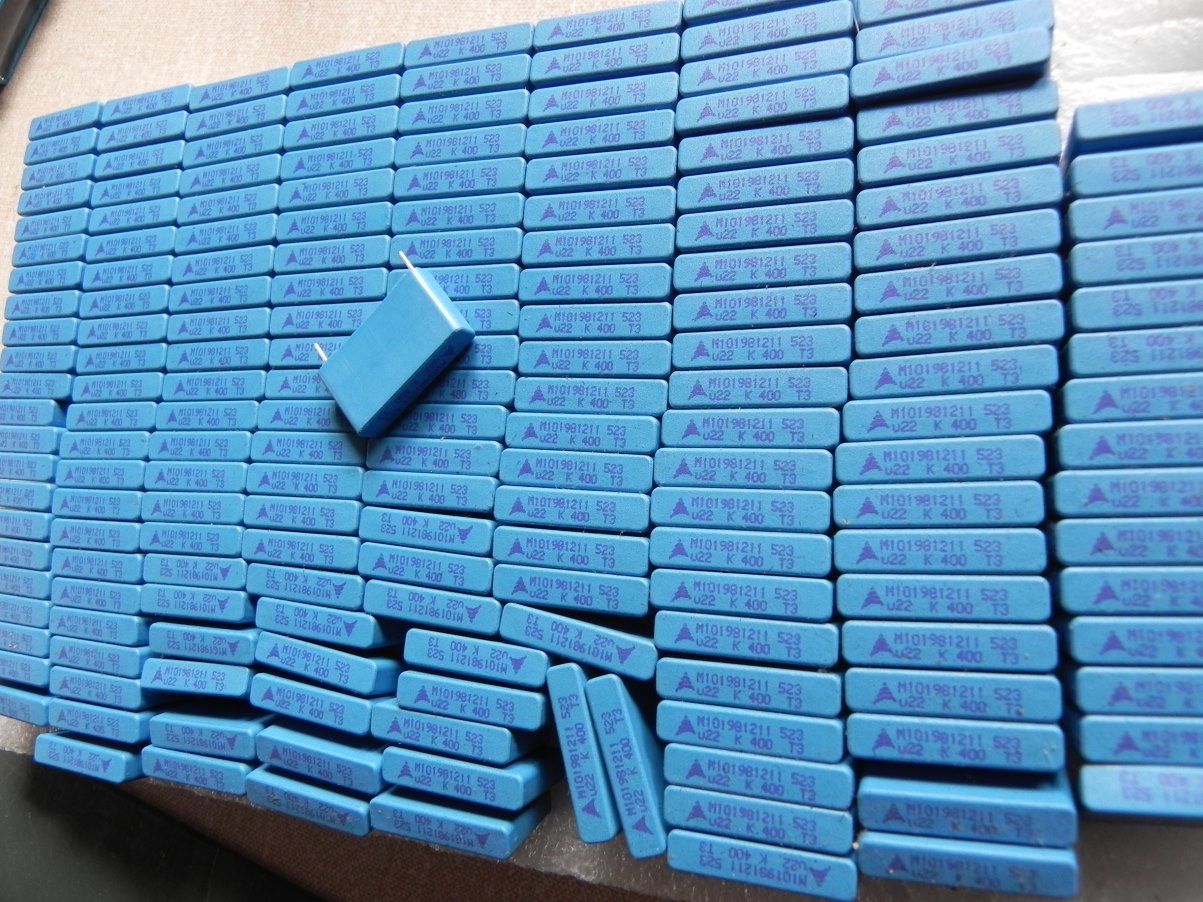  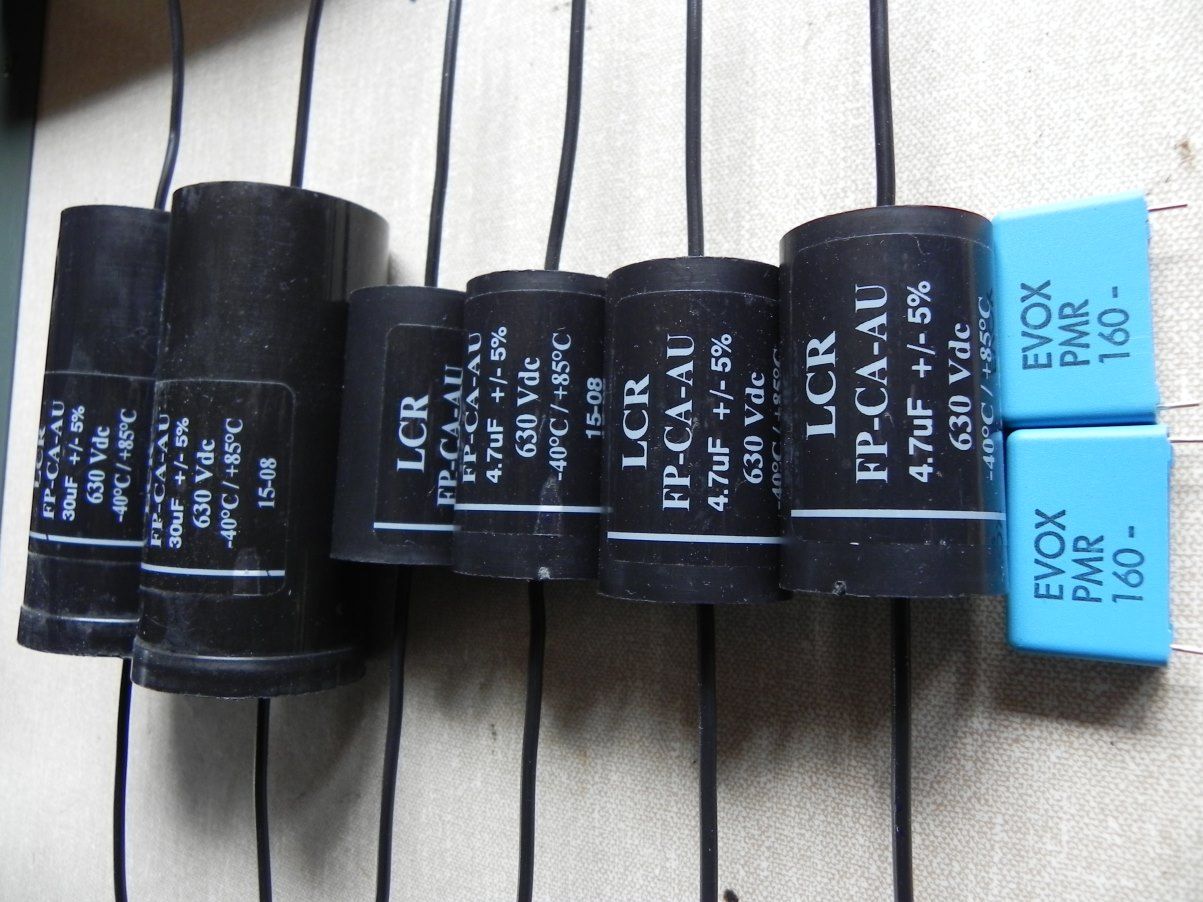 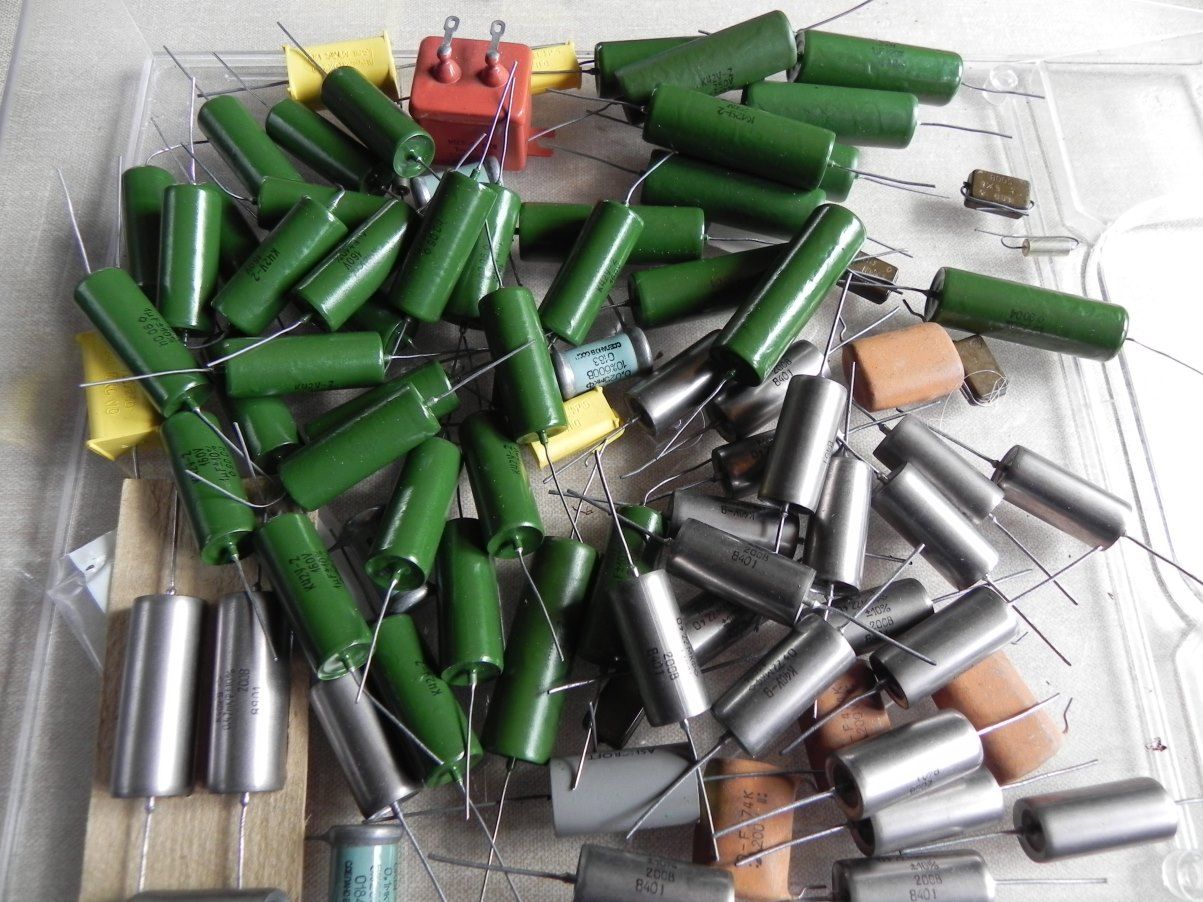 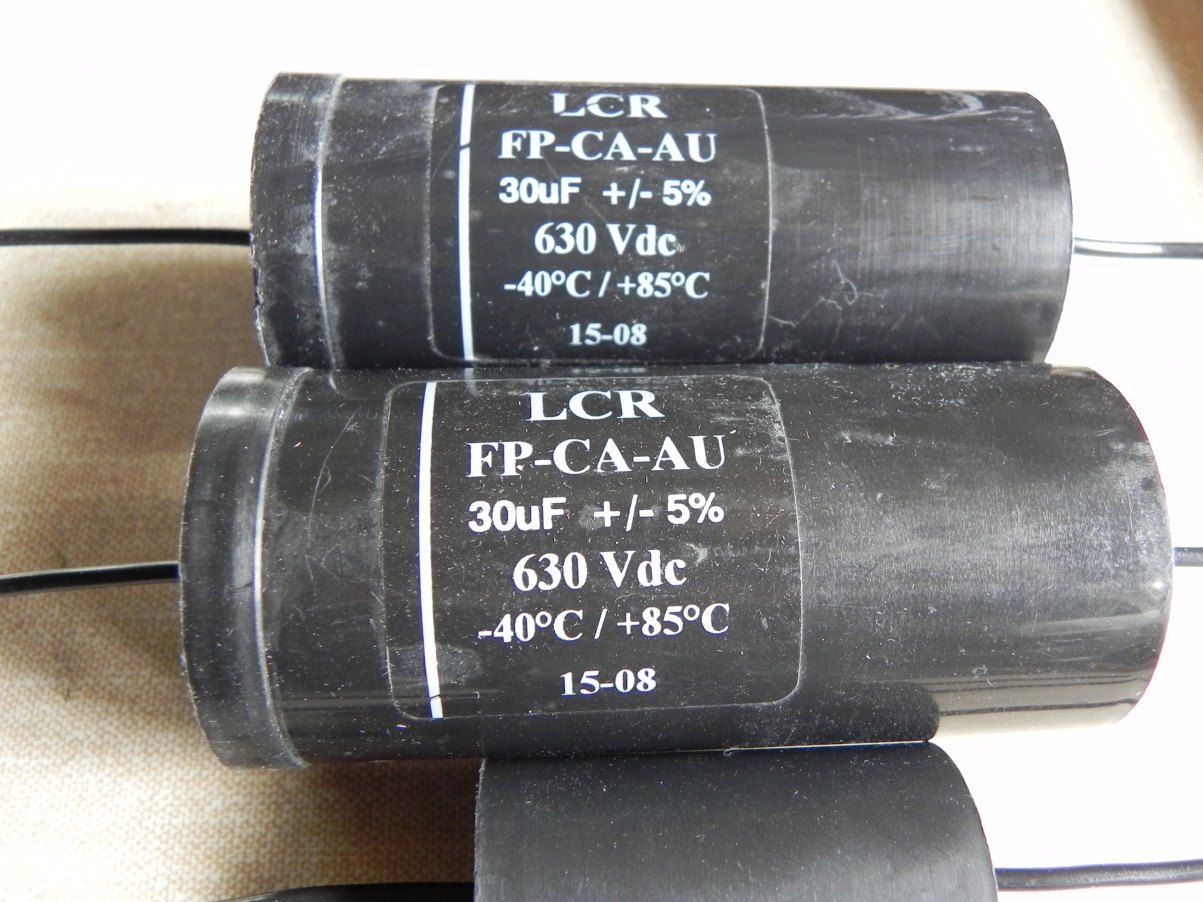 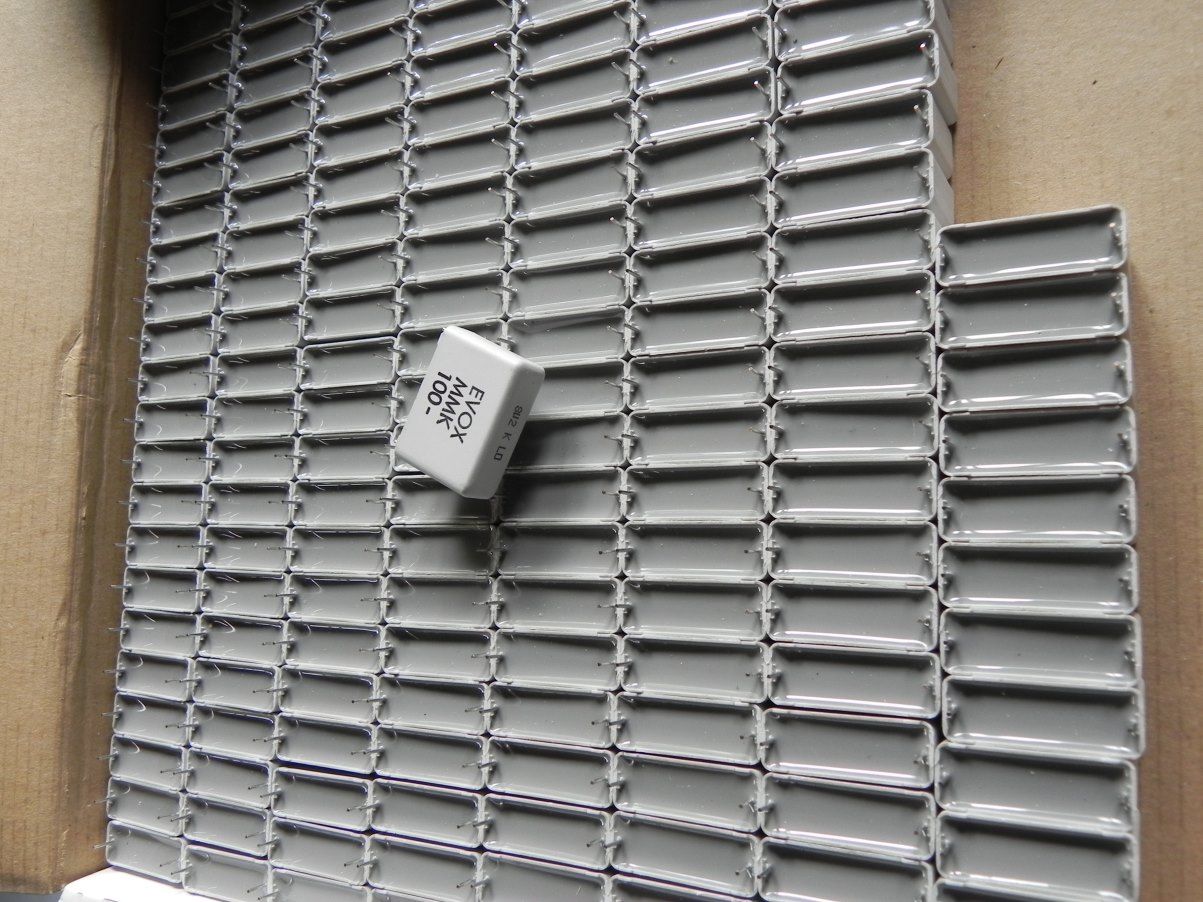 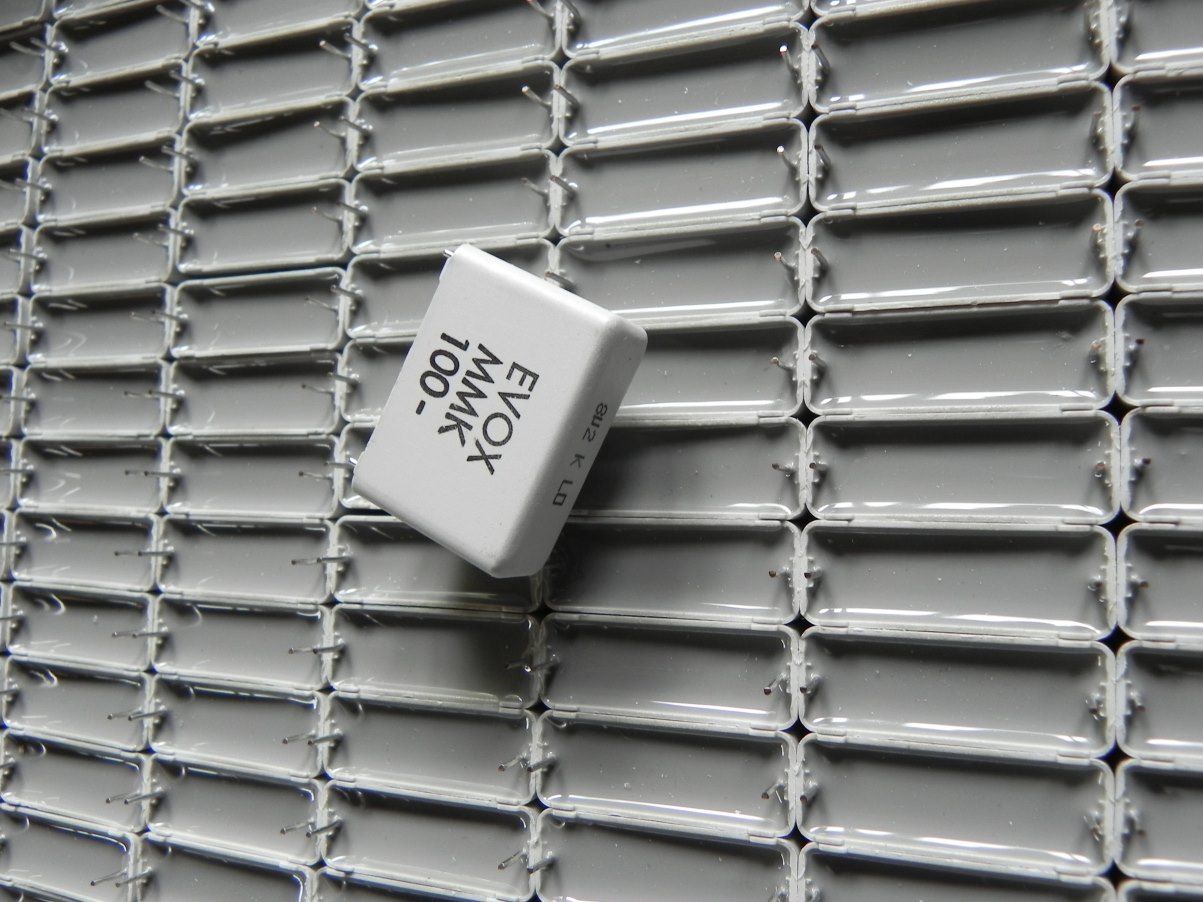   |
|
|
|
Post by PinkFloyd on Aug 1, 2017 20:30:21 GMT
EVOX were made in Sweden to the highest standard.... they were bought out by KEMET and god knows who makes them these days...... could be a blind Monkey in deepest China.... oh well, that's "progress"...... quite happy to find that box up in the rafters...... pure quality.
|
|
nando
Been here a while!  The Frying Dutchman
Always look on the bright side of life
The Frying Dutchman
Always look on the bright side of life
Posts: 393 
|
Post by nando on Aug 1, 2017 20:49:33 GMT
Spring clean he says... ;-)
You sound like a kid in a candystore.
These big Russian capacitors take up about halve of a x-cans!
I'll wait for your reply.
I've been searching the RS online store and finding my way around. I found out there is a Dutch variant as well.
Problem for me is that I know Jamicon and Teapo are to be avoided and Panasonic is good but will is sound good as well?
Are Rubicon's, Vishay, Nichicon etc. good? Difficult.
|
|
nando
Been here a while!  The Frying Dutchman
Always look on the bright side of life
The Frying Dutchman
Always look on the bright side of life
Posts: 393 
|
Post by nando on Aug 2, 2017 18:47:57 GMT
When you find some more big capacitors, I maybe have a purpose for that. I want to mod my two x-a200 and they have some big capacitors in them and enough room for more.
|
|
|
|
Post by PinkFloyd on Aug 3, 2017 7:58:14 GMT
When you find some more big capacitors, I maybe have a purpose for that. I want to mod my two x-a200 and they have some big capacitors in them and enough room for more. What values? |
|
nando
Been here a while!  The Frying Dutchman
Always look on the bright side of life
The Frying Dutchman
Always look on the bright side of life
Posts: 393 
|
Post by nando on Aug 3, 2017 11:16:31 GMT
When you find some more big capacitors, I maybe have a purpose for that. I want to mod my two x-a200 and they have some big capacitors in them and enough room for more. What values? Don't know yet. The x-a200 is quite a job to dismember (all 8 transistors are screwed to the outercasing and have coolingpaste) and from removing only the front panel it isn't possible to see the value of the big capacitors.  |
|
nando
Been here a while!  The Frying Dutchman
Always look on the bright side of life
The Frying Dutchman
Always look on the bright side of life
Posts: 393 
|
Post by nando on Aug 3, 2017 21:23:32 GMT
I'm learning. Visited the Jamicon site. The series MF uses SK, NK, TK, etc. are all 2000h capacitors.
SK is the standard serie.
TK series are rated 105C
NK series has NP writen on them which means they are non polar.
LP series stands for standard use snap-in elco's.
|
|
nando
Been here a while!  The Frying Dutchman
Always look on the bright side of life
The Frying Dutchman
Always look on the bright side of life
Posts: 393 
|
Post by nando on Aug 4, 2017 21:34:35 GMT
Problems with finding parts.
I am using RS-online, Conrad and Mouser webshops.
I'm finding it difficult to find non polar elco's on the web. I know Mike uses Nichicon Muze non polar caps but I can't find them AND are rated to max 50V. I need some 10uF 63+V non polar elco's.
I also can't find (except for aliexpress and alibaba) those 6 x RCA connector MF uses in x-pre and nu-vista.
There are also not a lot of 100V 1000+uF capacitors, prefferably 105+C and not higher than 3 cm.
I found a Panasonic which for all the requirements but is also 1000uF, so thats not more than the Jamicons they would replace. I would like to have more capacitance in the power supply.
I also have a Nichicon but this one has a pitch of 0,8 cm (pcb pitch is 1cm) and with little room to spare this will probably not fit inside the cabinet.
|
|
nando
Been here a while!  The Frying Dutchman
Always look on the bright side of life
The Frying Dutchman
Always look on the bright side of life
Posts: 393 
|
Post by nando on Aug 6, 2017 12:56:05 GMT
He Mike, I found out something. You fitted the EVOX 8u2 LO EVOX MMK 100- to Matt Newsome's x10-d on nov 5th 2013 (in post "work in progress" page 17, quarter way down the post). I guess these are the ones in the box you fould back recently in the rafters.
|
|
|
|
Post by PinkFloyd on Aug 6, 2017 20:38:37 GMT
He Mike, I found out something. You fitted the EVOX 8u2 LO EVOX MMK 100- to Matt Newsome's x10-d on nov 5th 2013 (in post "work in progress" page 17, quarter way down the post). I guess these are the ones in the box you fould back recently in the rafters. Yes.... amongst others  I really must get all of those up on ebay or somewhere. I tend to buy 100 and then if I find a better sounding cap I supply them with the kits and whatever is left of the "100" gets shoved up into the rafters. A really STUPID way of doing things, I know......... most people would use up the 100 first and THEN start supplying the better sounding caps but I'm not "most people"  it's no wonder that I'm not driving about in a fancy car and am (instead) driving about in a 14 year old car with 116,000 miles on the clock (absolutely LOVE it!!). I could easily use the 8.2uF in the kits but decided that 4.7uF sounded better (on balance) so decided to relegate the 94 x 8.2uF to the rafters. I am constantly trying to improve the sound of the X-10D Nando and the latest version of the kit is 20% better sounding than the one reviewed in the Australian Hi-Fi Magazine in March 2013: rockgrotto.proboards.com/thread/8998/little-pinkie-10d-upgrade-reviewTo me, it's not a "money" thing and many say that's my downfall..... to me it's a passion to get the best sound quality out of something at a price "real people" can afford and not punting out snake oil @ high prices to people with more money than sense are happy to dish out. My "pay day" is when I receive feedback from a fellow music lover who has a grin on his face....... if that's a downfall to some then so be it...... that's a lot more satisfying than "money" any day of the week!! I was experimenting a while back with different power resistors in the X-10D and the Ohmite Audio Gold (to my ears) gave the best bang for the buck so I am now supplying them (as standard) with the kits...... to my ears they definitely do the job, a lot more definition and minutiae of detail comes to the fore.... a definite improvement and now a permanent addition to the upgrade kit. Quite amazing what "one" resistor can do actually! I use the Mundorf resistors in the X-CAN V3 / V8 and X10-V3 buffer but same gig as the Ohmite Audio Gold in the X-10D. The first guy I tried the Mundorf resistor on was Ryz Hadjul with his X10-V3 buffer..... I didn't say a lot about it to him but luckily he decided to fit it and listen to it before fitting the entire V3 upgrade kit..... here is what he had to say: "Whoa Mike, What the foofah!... and I've only swapped out the 4 resistors for the single one! There I was, 3 rooms away in the kitchen making a cheese sarnie, waiting for the X-10 V3 to warm up and hells bells I could hear a difference from there! At first I thought the music had dropped 1 semitone but then I realised that everything was still there but considerably richer. The acoustic guitar and fiddles were now made of thicker wood and as for the double bass, well the bugger playing it was virtually squatting in my room. As for those annoying ringy/gratey upper-mids that show up randomly in vocals - dear Joni, I always knew you were an angel. I defy any deaf grandma not to hear the difference. Just a newborn resistor for foofah's sake - how can that be? Can't wait to put the rest of the gubbins in. Ryz" That was the four for one mod: rockgrotto.proboards.com/thread/10847/safe-remove-wirewound-resistors-v3Anyhoo....... off to bed soon........ early nights for me these days..... burnt way too many candle ends over the years  Mike. |
|











































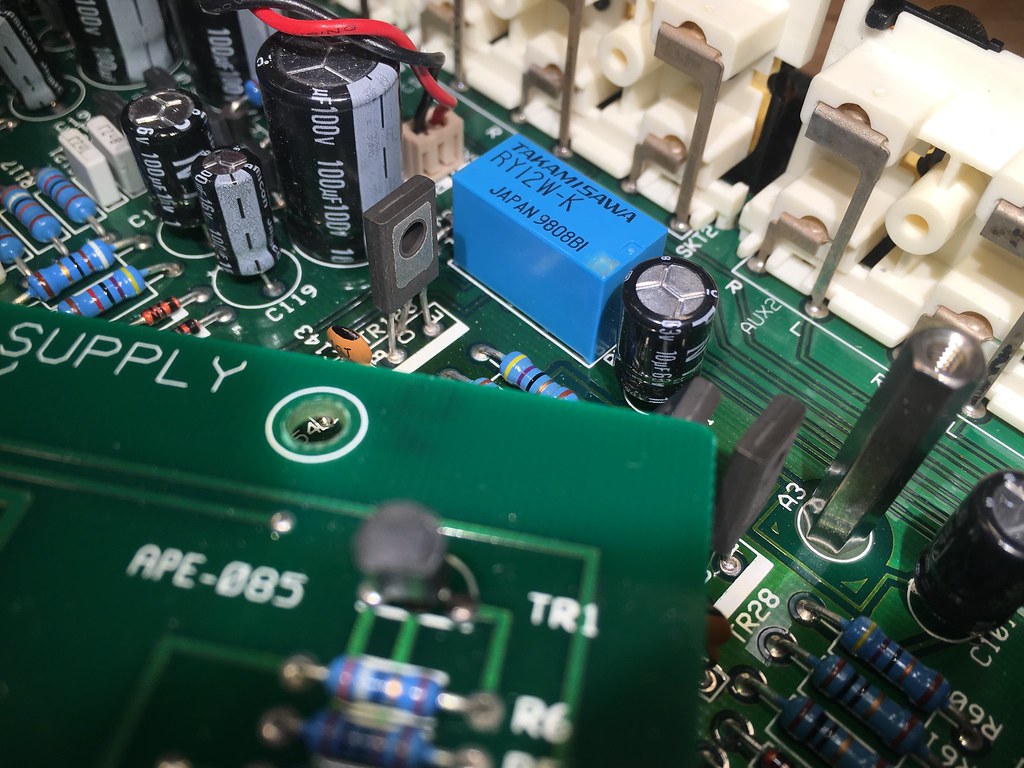




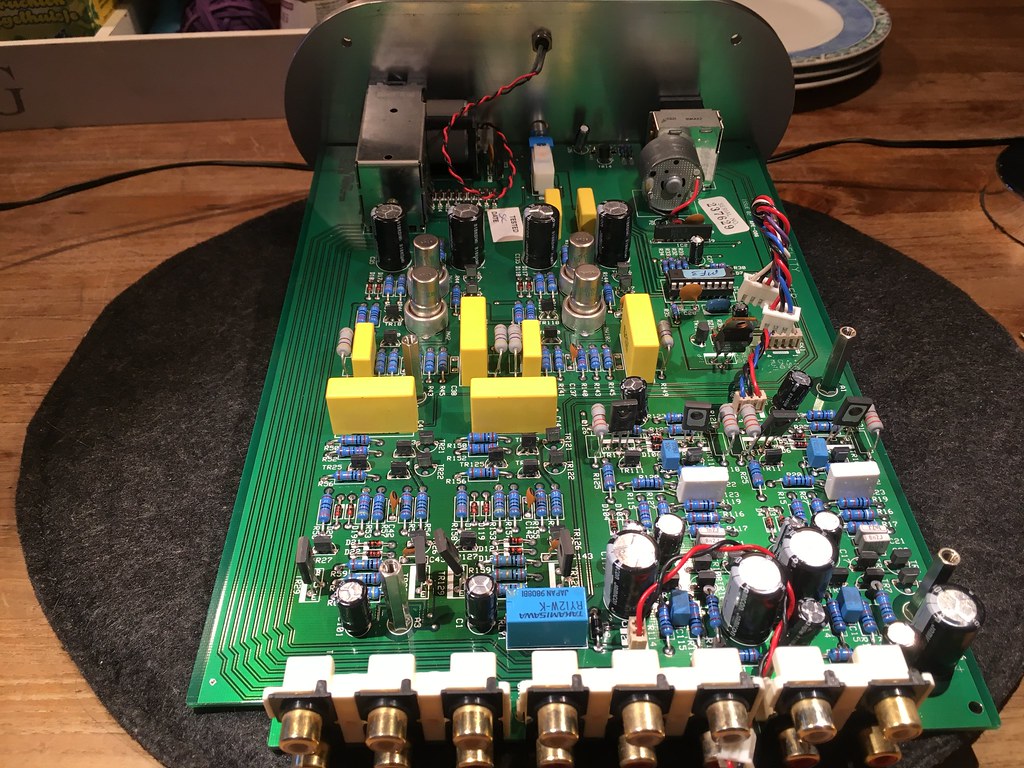







 (easy to do..... simply involves soldering an offcut capacitor leg to extend the stock 5mm leg to 10mm)
(easy to do..... simply involves soldering an offcut capacitor leg to extend the stock 5mm leg to 10mm) 








